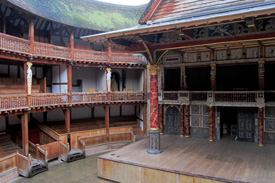 The Theatre and the Hope were the first and last playhouses built in Elizabethan London; today their archaeological remains have been given listed status, joining the Rose and the Globe as protected monuments of 16th and 17th century theatre. Of the two Elizabethan playhouses, the Theatre is said to have seen the first performance of Shakespeare’s Hamlet, becoming the site of three bear-baiting pits in that area of London.
The Theatre and the Hope were the first and last playhouses built in Elizabethan London; today their archaeological remains have been given listed status, joining the Rose and the Globe as protected monuments of 16th and 17th century theatre. Of the two Elizabethan playhouses, the Theatre is said to have seen the first performance of Shakespeare’s Hamlet, becoming the site of three bear-baiting pits in that area of London.
The Theatre was built in 1576/77 by James Burbage, on the junction of Curtain Road and New Inn Yard in Hackney, and a number of companies, including the Lord Chamberlain’s Company – which included William Shakespeare – were associated with it. It is believed to have been the first playhouse in which Hamlet was performed, in 1596 with Richard Burbage as the lead. Ahead of this, it is believed that Christopher Marlow’s Faustus was staged at the theatre in 1592.
The remains of the Theatre now lie beneath a modern mixed-use building in Hackney. It seems Burbage’s sons dismantled the theatre in late December 1598 after financial dispute, and moved reusable parts south of the Thames to Bankside for use in construction of their new venture, the Globe. The Hope was the last of the playhouses of the era, opening in approximately 1614 as a new building that would be a joint theatre and bear-baiting arena.
The first play performed at the Hope was Ben Jonson’s Bartholomew Fair, but animal baiting and other entertainment gradually took over the plays and the acting company left the Hope in 1617. It was ordered to close down by Parliament in 1643 but continued to operate until it was dismantled in 1656, the remains of which are located beneath a car park on the southern side of Riverside House on Southwark Bridge Road. Despite this, the archaeological remains provide small insights into this period in the history of theatre, of the first and last Elizabethan playhouses to be built in London.
